The brake on your bike is an indispensable system. And the most important component of this system is surely the brake pads.
The bike brake pads, also known as brake shoes or brake blocks, play a crucial role in your bike’s braking performance under a multitude of variable conditions. These are consumable, meaning that they will wear out with use but can be easily replaced.
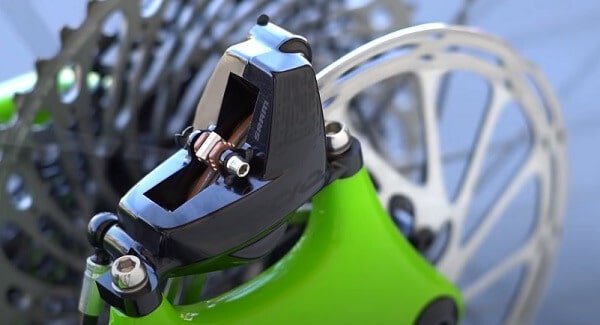
We can categorize bike brake pads into two types according to the two types of braking system that currently exists:
- Rim Brake Pads
- Disc Brake Pads
Both of these brake pad types are designed and manufactured to complement their respective braking systems and also the environment that they are most prominent in.
The Two Types of Brake Pads
1. Rim Brake Pads
As the name implies, rim brakes utilize the rim of the wheel as the braking surface. The two cantilever arms of the brake are mounted with the brake pads that engage the rim braking surface when the brake lever is squeezed. Which brings us to our first point of discussion:
Brake Pad and Rim Compatibility
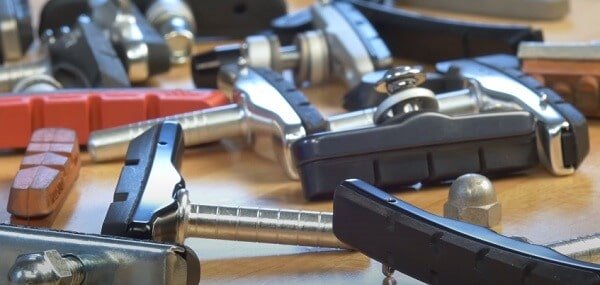
The section of the wheel rims that are used as a braking surface is made of either aluminum or carbon.
Aluminum or alloy rims are much better at conducting heat than carbon. This means that if proper brake pads aren’t used, the carbon rims can heat up and risk melting the resin that is holding the carbon fibers together. In such a case, the inner tubes of the wheel may get damaged, rendering the wheel virtually useless.
Carbon rims require the use of specifically created brake pads to control heat dissipation. These pads are softer and can easily wear away on harder braking surfaces. Thus you cannot use them on aluminum rims.
On top of that, using carbon specific braking pads on alloy rims can displace bits of metal that get embedded on the soft surface of the braking pads. If these pads are later used on carbon rims, the metal bits will erode the carbon braking surface and damage it.
So it is suggested that you use specific brake pads for specific rims.
Rim Brake Pad Systems
The brake pad is a combination of the block and the shoe. There are three basic types:
1. Road
The road brake pad system is connected to the arm of the caliper with a stud at the end. This pad usually has only a thin washer in-between the caliper and the stud. The length of the post is the shortest in this type of brake pad system.
2. Threaded Stud
Similar to the road pad, the threaded stud system is also fastened on to the arm of the caliper. These have two concave and two convex spacers screwed on either side of the connection. These have longer posts and provide higher stiffness to braking.
3. Smooth Stud
Unlike the threaded stud, the smooth stud system has a smooth post that extends from the pad. This post is held in place by a mechanism in the caliper arm. You can usually find them in cantilever brakes.
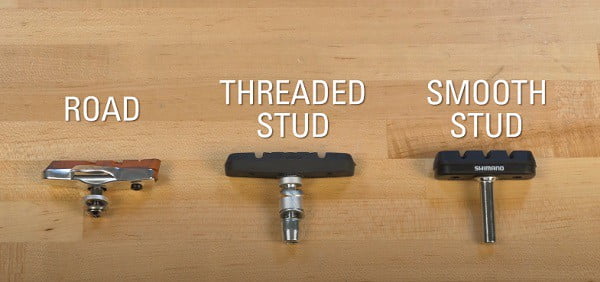
Are Brake Pad Blocks Replaceable?
The brake pad has two separate components, the block and the shoe, giving us a further two different options of brake pads
1. Non-Cartridge (Block)
The block and the shoe are permanently attached together. This is the simplest and the most inexpensive rim brake type. You have to replace the whole thing if replacement is necessary.
2. Cartridge
The block and the shoe of the brake pads can sometimes be separated. This type of rim brake pad is called a cartridge. You can replace the block like a cartridge when it wears out, making pad replacement that much easier and cheaper in the long run.
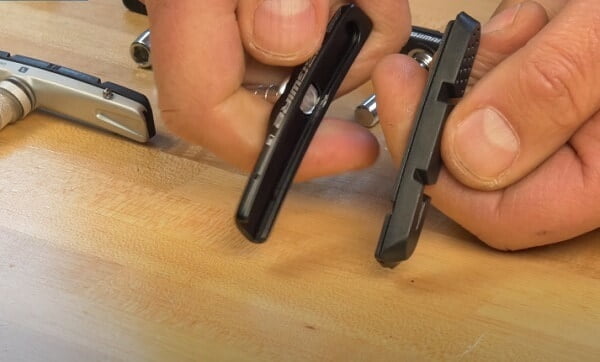
2. Disc Brake Pads
Disc brake pads are much less complicated in both design and also to understand. This is mostly thanks to the brake pads being taken away from the rim of the wheel to the newly added rotor of the disc brake system. This rotor, or disc, is located around the hub of the wheel.
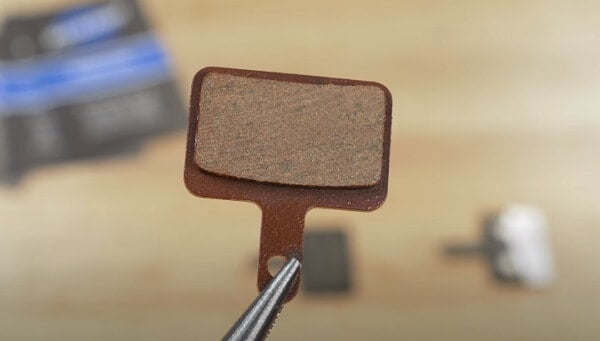
This deliberately removes any discussion of pad to braking surface compatibility and any thought of braking pads ruining your wheels as a whole.
That said, the only point of deliberation we can have with disc brakes are the…
Types of Disc Brake Pad Compounds
These are the compounds that exist on top of the metal plates and directly interact with the rotors to achieve braking. Depending on the type you braking performance can improve depending on where you are riding and how you are riding using disc brakes.
1. Metallic or Sintered
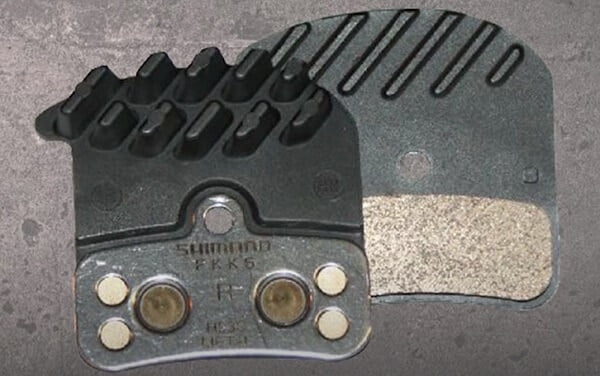
A compound of hardened metal acts as the base. These brake pads are the most robust among the three enabling it to have the highest lifespan.
They provide a decent performance in wet conditions and can cope well in high temperatures, making them perfect for technical off road biking like the downhill.
Pros
+ High longevity
+ Can withstand very high temperatures
+ Does not glaze over, very good for long descents
+ Provides a lot of sustained power
Cons
– Can take a while to bed in due to their stiffness
– Can be noisy
2. Organic or Resin

The resin holds together a combination of organic material to be used as a base for this compound. It is soft allowing it to quickly bed in and be quiet at the same time.
These are the standard for all disc brake pads, being inexpensive and perfect for new cyclists who are still deciding on their discipline.
Pros
+ Beds in quickly
+ Good initial bite
+ Quiet
Cons
– Does not last as long as sintered
– Can glaze over
3. Semi-Metallic
A go between for sintered and resin pads. They incorporate organic material and metal in resin on a metal back plate and try to bring out the advantages of both.
Their overall performance depends on how much metal the manufacturer has used in the compound.
Pros
+ Takes advantages of the positives of both sintered and resin pads
+ Good top-end power
+ Modulation and overall feel is good
+ Good durability
Cons
– Can glaze over in longer descents
– Different brands have different mix ratios, choosing the perfect pad to match your riding style can be complicated
– Can be expensive
Final Words
Previously, each type of brake pad was used in specific riding disciplines: rim brakes for road and disc brakes for off-road cycling. The line has since then blurred.
You can modify each type of brake system to use them under any variable that you can imagine. And that’s a lot.
With all the types and sub-types of braking pads out there, we hope that we have described them well enough to clear any inquiries that you might have had.
Please feel free to peruse this article again as needed.
Frequently Asked Questions
Q1) Do all brake pads fit all calipers?
Ans.: The simple answer is no. The caliper width will determine the size of the brake pads. The space between the brake pads and the braking surface needs to be at a minimum so that you do not have to squeeze your brake levers all the way to achieve braking, even in dangerous situations.
You also need to make sure that new brake pads are ‘broken in’ to make them last longer.
Q2) Are all disc brake pads the same size?
Ans.: No. Disc brake pads have a wide range of shapes. You have to ensure the brake pads are compatible with your brakes before making a purchase.
We suggest that if you are happy with your current type of brake pad, then you don’t really have to branch out on a new type.
